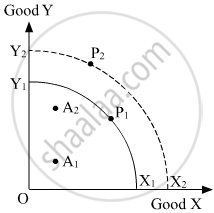Advertisements
Advertisements
प्रश्न
Explain the problem of what to produce.
उत्तर
What to produce refers to the selection of the goods and the quantity to be produced of each selected commodity. This problem arises because resources are scarce and have alternative uses. As many goods can be produced from these resources, the problem is that which of the goods should be produced.
संबंधित प्रश्न
Demand for perishable goods is inelastic.
Define demand. Name the factors affecting market demand.
Distinguish between ‘increase in demand’ and increase in quantity demanded of a good.
Answer the following question.
State and explain the law of demand.
Write Explanatory answer.
State and explain the law of demand with its exception.
Fill in the blank with appropriate alternatives given in the bracket:
The law of demand states ________ relation between demand and price.
Fill in the blank with appropriate alternatives given below:
Indirect demand is also known as _____________ demand.
Give reason or explain the following statement.
Increase in demand indicates a rightward shift in the demand curve.
Choose the correct answer from given options
In the given figure X1Y1 and X2Y2 are Production Possibility Curves in two different periods T1 and T2 respectively for Good X and Good Y. A1 and A2 represent actual outputs and P1 and P2 represent potential outputs respectively in the two times periods.

The change in actual output of Goods X and Y over the two periods would be represented by a movement from __________.
From the set of statements given in Column A and Column B, choose the correct pair of statement:
| Column A | Column B |
| 1. Reduction of pollution | (a) Microeconomics |
| 2. Problems due to unemployment | (b) Microeconomics |
| 3. Shift in the demand curve | (c) Microeconomics |
| 4. Government expenditure on building of roads | (d) Microeconomics |
Are the concepts of demand for domestic goods and domestic demand for goods the same?
Identify the correct pair of items from the following Columns I and II:
| Column I | Column II |
| (1) Utility | (a) Bread and butter |
| (2) Normal Goods | (b) Rise in price |
| (3) Contraction in demand | (c) Capacity of a commodity to satisfy human wants. |
| (4) Complementary goods | (d) Positively related |
What will be the effect on equilibrium price and equilibrium quantity when income increases in case of normal goods?
Which of the following statements is true?
Identify the market form which has indeterminate demand curve:
Read the following news report and answer the Q.97-Q.100 on the basis of the same:
The quantity of a commodity that a consumer is willing to buy and is able to afford, given the prices of goods and the consumer's tastes and preferences is called demand for the commodity. Whenever one or more of these variables change, the quantity of the good Chosen by the consumer is likely to change as well. The relation between the consumer's optimal choice of the quantity of a good and its price is very important and this relation is called the demand function. Thus, the consumer's demand function for a good gives the amount of the good that the consumer chooses at different levels of its price when the other things remain unchanged.
Assertion: The income of the consumers remains unchanged
Reason: Commodity should be a normal good.
Select the correct alternative from the following.
Which of the following statement is true?
"Market demand curve is constructed by horizontally summing all the individual's demand curves at each and every price." Choose the correct option for the above-mentioned statement.
When the price of the commodity has changed the demand for the commodity changes in ______
